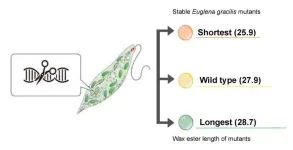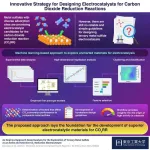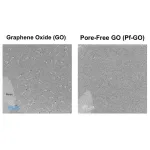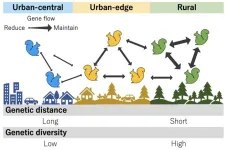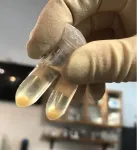(Press-News.org) In a new study by the Potsdam Institute for Climate Impact Research (PIK), researchers analysed how erratic weather events, increasingly intensified by global warming, affect global production and consumption across different income groups. The results confirm previous studies that the poorest people worldwide bear the greatest economic risks from climate change. Surprisingly, the risk for the wealthy is growing the fastest. Economies in transition like Brazil or China are also highly vulnerable to severe impacts and negative trade effects. Across countries, these countries face the highest risks due to severe impacts of volatile weather and adverse trade effects. As the planet continues to warm, these risks are expected to worsen across most countries, with ripple effects along global supply chains, impacting goods and services worldwide.
“In the next 20 years, climate change will increase economic risks from erratic weather”, states PIK scientist Anders Levermann. “The highest risks remain with the poorest around the world. But the increase of economic risk is strongest for the wealthy, in countries like the US and the EU. Consumers all around the world, regardless of their income, will thus face increasing challenges due to global warming – without a transition towards carbon neutrality we will eventually not be able to meet these challenges.”
Lennart Quante, Sven N. Willner, Christian Otto, Anders Levermann (2024): Global economic impact of weather variability on the rich and the poor. Nature Sustainability. [DOI: 10.1038/s41893-024-01430-7]
END
Global warming's economic blow: Risks rise more rapidly for the rich
2024-09-13
ELSE PRESS RELEASES FROM THIS DATE:
CRISPR/Cas9 modifies euglena to create potential biofuel source
2024-09-13
News about biofuels sometimes mentions used cooking oil as a feedstock, but if these substances contain animal fat, they can solidify in colder temperatures. This happens because, chemically, the fatty acids of these and many other saturated fats have long carbon chains with single bonds. Enter the euglena. An Osaka Metropolitan University team has found a way to have one species of this microalgae produce wax esters with shorter carbon chains than usual.
Using CRISPR/Cas9 to edit the genome of Euglena gracilis, Dr. Masami Nakazawa and her team at the Graduate School of Agriculture’s ...
New 'PVDF alternative battery binder' surpasses EU environmental regulations!
2024-09-13
A team led by Dr. Hyeon-Gyun Im and Dr. Dong Jun Kang from the Insulation Materials Research Center of Korea Electrotechnology Research Institute (KERI), in collaboration with Dr. Jung-keun Yoo from KIST and Professor Jong-soon Kim from Sungkyunkwan University, have developed a technology that enhances the performance of binders—often the 'unsung heroes' in the field of secondary batteries—while using environmentally friendly materials. This technology has been published in a prestigious international ...
The Menopause Society launches Making Menopause Work™ Initiative
2024-09-13
CHICAGO (Sept 13, 2024)—Menopause is a natural life transition occurring when many women are at the “top of their game.” Unsupported menopause symptoms drive up employer healthcare costs and cause roughly $1.8 billion in missed workdays. To help employers retain these valued workers and build cultures of well-being, The Menopause Society launched Making Menopause Work™ based on new science-based Consensus Recommendations. The Recommendations are published online in Menopause, the journal of The Menopause ...
Exploring ternary metal sulfides as electrocatalyst for carbon dioxide reduction reactions
2024-09-13
One of the most promising avenues for actively reducing CO2 levels in the atmosphere is recycling it into valuable chemicals via electrocatalytic CO2 reduction reactions. With a suitable electrocatalyst, this can be achieved under mild conditions and at a low energy cost. Many types of electrocatalysts are being actively investigated, but most suffer from either low electrocatalytic activity, poor selectivity, or low stability.
Metal sulfides might hold the huge potential solution to this puzzle. By combining ionic and covalent characteristics, this unique family of materials offers good catalytic activity and energy efficiency. The ternary metal system is expected to be a better ...
Breakthrough in proton barrier films using pore-free graphene oxide
2024-09-13
Kumamoto University’s research team, led by Assistant Professor Kazuto Hatakeyama and Professor Shintaro Ida of Institute of Industrial Nanomaterials, has announced a groundbreaking development in hydrogen ion barrier films using graphene oxide (GO) that lacks internal pores. This innovative approach promises significant advancements in protective coatings for various applications.
In their study, the research team successfully synthesized and developed a thin film from a new form of graphene oxide that does not contain pores. Traditionally, ...
Urbanization has impacted the population genetic structure of the Eurasian red squirrel in Japan within a short period of 30 years
2024-09-13
Since many kinds of wildlife have started living in urban environments, urban environments have been recognized as places of biodiversity conservation. What kind of factors facilitate or prohibit wildlife from living in urban environments? Understanding the population genetic structure of urban wildlife living would suggest the hint. In this study, we investigated the population genetic structure of Eurasian red squirrels living in urban to rural areas in Obihiro City, Hokkaido, Japan. As a result, we found that ...
Experimental mRNA cancer vaccine shows potential for advanced stage cancer patients in Phase 1 trial
2024-09-13
Interim data from the Phase I dose escalation part of the mRNA cancer immunotherapy (mRNA-4359), show promise in patients with advanced solid cancers.
The investigational mRNA cancer immunotherapy is targeted for patients with lung cancer, melanoma and other solid tumours. Nineteen patients with advanced stage cancers received between one and nine doses of the immunotherapy treatment. Scientists have found the immunotherapy created an immune response against cancer and was well tolerated, with adverse events ...
Rapid new blood diagnostic test for ALS
2024-09-13
(Jackson, Wyoming – Embargoed until Thursday 12 September 2024 8:00 PM EDT)
A highly accurate diagnostic blood test has been developed for amyotrophic lateral sclerosis (ALS), a progressive neurodegenerative disease that effects neurons in the brain and spinal cord.
ALS leads to gradual paralysis, ultimately resulting in the inability to walk, speak, or, in later stages, move. Currently, diagnosis is based on a thorough clinical examination, but it can take up to 12 months to provide a definitive diagnosis, by which time many patients have significantly ...
Ignore antifungal resistance in fungal disease at your peril, warn top scientists
2024-09-12
Without immediate action, humanity will potentially face further escalation in resistance in fungal disease, a renowned group of scientists from the across the world has warned. The commentary - published in The Lancet this week - was coordinated by scientists at The University of Manchester, the Westerdijk Institute and the University of Amsterdam. According to the scientists most fungal pathogens identified by the World Health Organisation - accounting for around 3.8 million deaths a year - are either already resistant or rapidly acquiring resistance to antifungal drugs.
The authors argue that the currently narrow focus on bacteria will not fully combat antimicrobial resistance ...
Increased testing for heart disease indicator needed worldwide
2024-09-12
Review in The Lancet finds that one in five globally are at risk of contracting cardiovascular diseases, because they carry a genetic risk of high levels of a specific lipoprotein, which can be tested for and possibly treated.
20 % of the world population carries a genetic risk factor for cardiovascular diseases such as heart attacks, strokes, and aortic valve stenosis: Increased levels of a lipid particle called lipoprotein(a). It is the most common genetic cause of cardiovascular diseases.
“Lipoprotein(a) is the direct cause of cardiovascular diseases much like cigarettes cause ...
